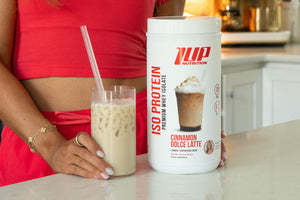With many individuals unable to train as they normally would, there’s growing concern that fitness enthusiasts will be at a heightened risk for muscle breakdown. This is a result of a combination of things, including reductions in physical activity (resistance training) and food intake (protein) -- both of these are needed to maintain muscle mass.
And, while muscle does ascribe to the “use it or lose it” axiom (at least partially), the good news is that you can halt muscle loss to a significant degree by doing two things -- performing resistance training (even with just your body weight) and consuming enough dietary protein.
Now, suppose you don’t have a home gym and the thought of doing bodyweight exercises is about as appealing as getting a root canal.
Well, then you’ll be relieved to know that some research indicates that even in the absence of consistent, hard training you’ll still be able to retain your hard-earned muscle by consuming enough dietary protein, and we’re here to break it all down for you.
So, let’s get started!
Halt Muscle Breakdown with Protein
A 2013 review titled “Nutritional strategies to attenuate muscle loss” stated that:
“Evidence suggests that maintaining protein intake during a period of disuse attenuates disuse atrophy. Furthermore, supplementation with dietary protein and/or essential amino acids can be applied to further aid in muscle mass preservation during disuse.”[1]
Researchers found evidence that eating enough protein when individuals were not in a position to use their muscles as they normally would help maintain muscle mass.
Additionally, they said that dietary protein (such as whey protein powder) or essential amino acids (EAA) were viable options to preserve muscle mass during periods of low activity.
A good goal to shoot for regarding daily protein intake, whether you’re resistance training or not, is between 1-1.25 grams of protein per pound of bodyweight.
1UP Nutrition offers an extensive array of premium-quality protein powders to help individuals meet their increased protein needs. And, for added muscle support, 1UP also has developed a Men’s and Women’s BCAA/EAA formulas that provide generous amounts of all the essential amino acids required by the body to synthesize protein.
One of the most interesting points mentioned in the 2013 review was that consuming as little as 16.5g of essential amino acids (containing 3.1 g of leucine) three times daily helped prevent any noticeable loss of muscle mass during 28 days of bed rest in healthy individuals.[1]
Now, most research to date on muscle “disuse” occurs in those who are critically ill and/or elderly, but there is some research conducted on athletes who may be dealing with an injury.[5]
In the study, the team of researchers stated[5]:
"Dietary consumption [of protein] is of critical importance for stimulating muscle protein synthesis rates throughout the day...maintaining or increasing daily protein intake by focusing upon the amount, type, and timing of dietary protein ingestion…can restrict the loss of muscle mass and strength during recovery from injury."
In other words, if you’re dealing with a layoff from training, make sure to focus on consuming enough high quality protein each day (such as beef, chicken, eggs, and/or whey protein). Evenly spacing your protein feedings throughout the day may also promote a positive nitrogen balance in the body, which benefits muscle retention and resists muscle breakdown.
Leucine is Key
Leucine is commonly regarded as the “king” of amino acids due to the fact that it is a powerful stimulator of mTOR (mechanistic target of rapamycin) -- a protein that kickstarts muscle protein synthesis in the body.
In addition to stimulating protein synthesis in the body, leucine also possesses anti-catabolic properties, which means it prevents protein (muscle) breakdown.[2]
It comes as little surprise then that leucine-enriched protein supplementation has been shown to both promote anabolism (muscle building) and combat catabolism.[3,4]
More specifically, researchers added 3 grams of leucine (the same amount contained in 1UP Her BCAA/EAA) to a 30-gram serving of protein.[3]
Other Supplements to Combat Muscle Loss
Muscle researchers have also investigated several other compounds for their ability to help combat muscle loss during periods of reduced physical activity.
The two compounds that have shown the most promise are Omega-3 fatty acids (like those contained in 1UP Omega-3) and the most well-researched, consistently proven effective supplement in the history of sports nutrition -- creatine monohydrate.
1UP Pure Rebuild provides a full 5 grams of creatine in every serving.
Takeaway
Dedicated gym rats never relish layoffs from training, be it due to injury, illness, or gym closures.
However, while you might not be able to train as you normally would, you don’t have to sacrifice all the results you’ve worked so hard to achieve.
Retaining lean muscle mass during a gym layoff begins with consuming enough dietary protein each day from high-quality sources (beef, chicken, eggs, whey protein, etc.).
You can further protect against muscle loss by doing a few simple bodyweight workouts each week. Even something as simple as a few sets of push ups, pull ups (or inverted rows), and lunges will be enough to help retain your results during a layoff. It doesn’t have to be anything fancy. The body doesn’t “want” to lose muscle mass, but it will if it’s completely unused.
As such, make sure you’re consuming enough protein each day and doing some kind of physical activity to protect against muscle loss.
And, for a final good measure, you may also want to consider supplementing with essential amino acids as well as creatine and omega-3 fatty acids as each of these has data supporting their ability to help combat muscle breakdown.
References
- Wall, B. T., & van Loon L. J. C. (2013). Nutritional strategies to attenuate muscle disuse atrophy. Nutrition Reviews, 71(4), 195-208.
- Baticci F, Bozzetti F. Anticatabolic properties of branched chain amino-acids in post-operative patients. A prospective study. Clin Nutr. 1990;9(5):246-252. doi:10.1016/0261-5614(90)90032-n
- Thalacker-Mercer, A. & Drummond, M. (2014). The importance of dietary protein for muscle health in inactive, hospitalized older adults. Annals of the New York Academy of Sciences. 1328(1), 1-9.
- Galvan, E., Arentson-Lantz, E., Lamon, S., & Paddon-Jones, D. (2016). Protecting skeletal muscle with protein and amino acid during periods of disuse. Nutrients, 8, 404.
- Wall, B. T., Morton, J. P., & van Loon, L. J. C. (2015) Strategies to maintain skeletal muscle mass in the injured athlete: nutritional considerations and exercise mimetics. European Journal of Sport Science, 15(1), 53-62.






